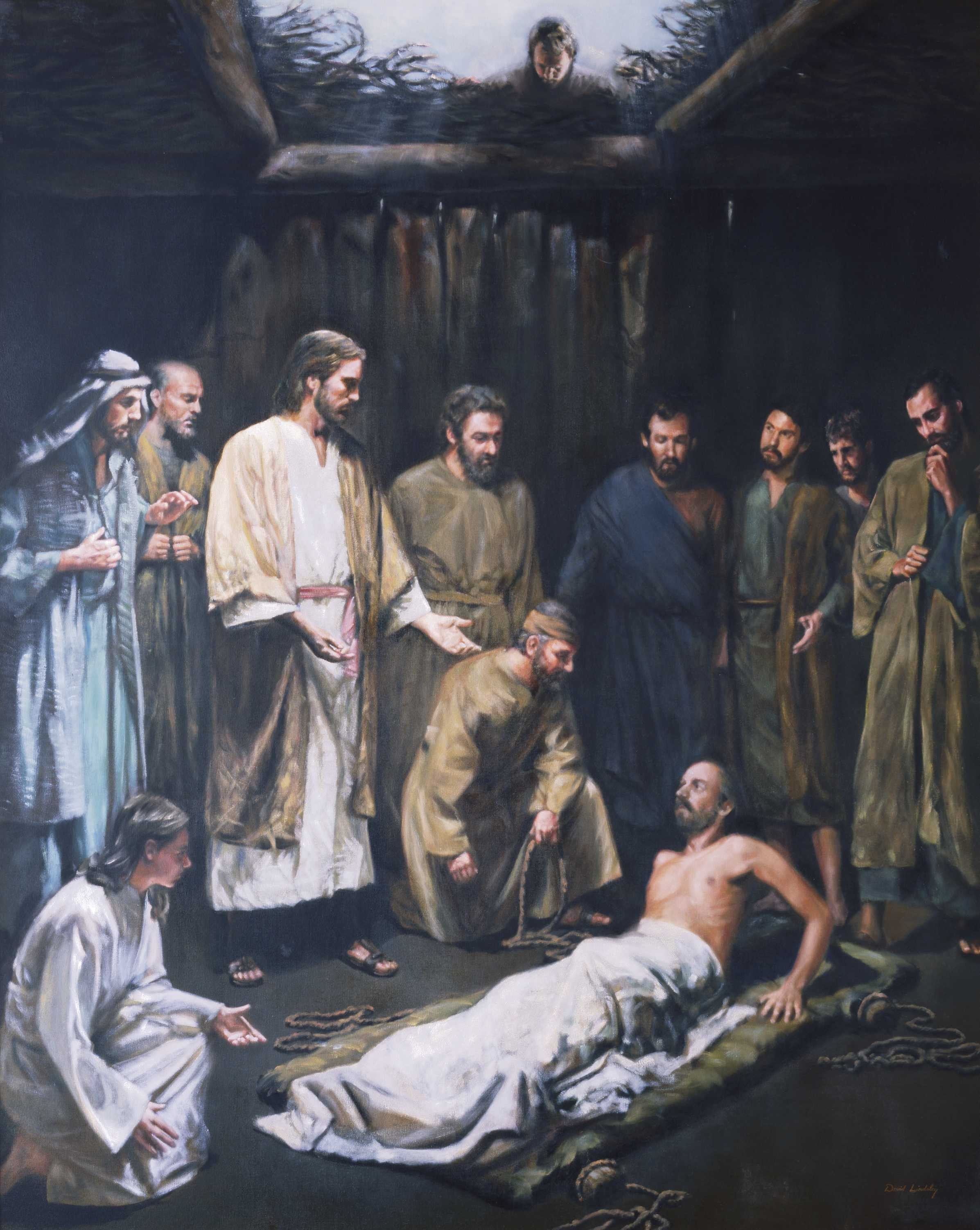“Learning Experience 8: Understanding, Feeling, and Applying Doctrine and Principles,” New-Teacher Training Resource: A Teacher-Improvement Companion to the Gospel Teaching and Learning Handbook (2016)
“Learning Experience 8,” New-Teacher Training Resource
Learning Experience 8
Understanding, Feeling, and Applying Doctrine and Principles
Overview
This learning experience covers the following concepts:
-
Getting the gospel into our hearts
-
Understanding doctrine and principles
-
Feeling the truth and importance of doctrine and principles
-
Applying doctrine and principles
Key Concepts
The learning pattern provides fundamentals that help instill the gospel in our minds and hearts. In this learning experience, we will address understanding, feeling the truth and importance of, and applying doctrine and principles.
The purpose of this learning experience is to provide a brief introduction to aspects of the learning pattern. As you serve as a seminary or institute teacher, you will have many more opportunities to learn about and practice these skills.
Understanding, Feeling the Truth and Importance of, and Applying Doctrine and Principles
The parable of the gems is a metaphor for studying the scriptures. The following three elements help us understand what we can do in our study after we have identified important gospel truths.
-
Understand doctrine and principles
-
The young woman studied each gem she discovered, carefully exploring its shapes and facets.

-
As we discover gems of truth in the form of doctrine and principles, we can carefully study each one to better understand its meaning and significance.
-
Feel the truth and importance of doctrine and principles

-
The young woman felt an appreciation for each gem grow within her.

-
As we gain a deeper understanding of the truths we discover, we feel their importance, relevance, and urgency.
-
Apply Doctrine and Principles

-
The young woman’s father invited her to consider what she might do with the gems she had discovered.

-
Having gained a testimony of and appreciation for a doctrine or principle, we should consider specific ways we can apply it in our own lives.
Latter-day prophets and apostles have emphasized the importance of getting the gospel deep into our hearts. Understanding the context and content of the scriptures in order to identify important gospel doctrine and principles is a good start to gaining knowledge of the truths of the gospel. But to help what we know in our minds sink deep into our hearts, there is often more we must do. We must seek to:
-
Understand the doctrine and principles we have identified.
-
Feel of their truth and importance.
-
Apply them in our lives.
These three elements of the learning pattern work together to invite the Holy Ghost, who helps us get the gospel deep into our hearts.
Gospel Teaching and Learning Handbook Activity

Gospel Teaching and Learning: A Handbook for Teachers and Leaders in Seminaries and Institutes of Religion (2012) contains important information about each of these aspects of the learning pattern. Explore what the handbook teaches by reading the indicated sections in the handbook and answering the corresponding questions.
-
Understand doctrine and principles
Search section 2.5.2 (“Understand Doctrine and Principles”) on pages 28–29 of your Gospel Teaching and Learning handbook. As you study, look for answers to the following questions:
-
What does it mean to “understand a gospel doctrine or principle”?
-
How can I increase my understanding of the gospel doctrine and principles I identify?
-
-
Feel the truth and importance of doctrine and principles
Search section 2.5.3 (“Feel the Truth and Importance of Doctrines and Principles”) on pages 29–30 of your Gospel Teaching and Learning handbook. As you study, look for answers to the following questions:
-
Why is it important for me to feel the truth and importance of a doctrine or principle I have identified?
-
What can I do as a learner to invite the influence of the Spirit to help me feel the truth and importance of a principle or doctrine I have identified?
-
What role does the Holy Ghost play in this process?
-
-
Apply doctrine and principles
Search section 2.5.4 (“Apply Doctrine and Principles”) on pages 30–31 of your Gospel Teaching and Learning handbook. As you study, look for answers to the following questions:
-
How do I know when I am applying a gospel principle I have learned?
-
What will happen in my life as I seek to apply the doctrine or principle I have identified?
-
What can I do in my personal study to focus more on applying the truths I am learning?
-
Of all the material you just studied in the Gospel Teaching and Learning handbook, let’s focus on three key suggestions. In the following list, each element is paired with one action you can take as you seek to understand, feel the truth and importance of, and apply the truths you learn in the scriptures.
-
Understand doctrine and principles
Analyze the meaning of the doctrine or principle by asking questions and searching for answers.
-
Feel the truth and importance of doctrine and principles
Reflect on the impact the principle has had in your life or in the lives of others.
-
Apply doctrine and principles
Consider what specific action you should take to apply the doctrine or principle in your life.
Applying the Learning Pattern
![]() Watch the video “Understand, Feel, and Apply Principles” (7:12), available on ChurchofJesusChrist.org. In this video, three teachers discuss their efforts to understand, feel the truth and importance of, and apply doctrine and principles in Luke 5:1–11.
Watch the video “Understand, Feel, and Apply Principles” (7:12), available on ChurchofJesusChrist.org. In this video, three teachers discuss their efforts to understand, feel the truth and importance of, and apply doctrine and principles in Luke 5:1–11.
Understand, Feel, and Apply Principles
![]() Record two or three ideas that stood out to you as you watched this discussion in a study journal or another place where you can refer to them and share them with your inservice leader or group.
Record two or three ideas that stood out to you as you watched this discussion in a study journal or another place where you can refer to them and share them with your inservice leader or group.
Guided Practice Activity

In Ether 6:1–12, we read that the Lord caused the wind to direct the Jaredite barges to the promised land. The following is one principle we could identify in this passage: As we trust in the Lord and do His will, He will direct the course of our lives. Follow the steps below in an effort to understand, feel the truth and importance of, and apply this principle. Record your answers and insights in your scriptures or personal journal.
-
Develop your understanding of the principle
Analyze the meaning of the principle by asking questions such as the following and searching for answers:
-
What does it mean to trust?
-
What does it mean to trust in the Lord?
-
Why is the Lord able to direct the lives of those who trust Him?
-
How does the Lord direct the course of an individual’s life?
-
-
Seek to feel the truth and importance of the principle
Reflect on the impact the principle has had in your life or in the lives of others, including individuals from the scriptures or Church history.
-
In what ways does your life and testimony reflect the truth of this principle?
-
In what ways do the lives and testimonies of others you thought of reflect the truth of this principle?
-
-
Apply the principle
Consider what specific action you should take to apply the doctrine or principle in your life.
Self-Practice Activity

Select a principle you identified in your study of Luke 5:12–26 in learning experience 7 or select a principle identified in section 3.2 (“Luke 5: An Example”) on pages 42–46 of the Gospel Teaching and Learning handbook. Then do the following:
-
Develop your understanding of the principle.
Analyze the meaning of the doctrine or principle by asking questions and searching for answers.
-
Seek to feel the truth and importance of the principle.
Reflect on the impact the principle has had in your life or in the lives of others.
-
Apply the principle.
Consider what specific action you should take to apply the doctrine or principle in your life.
 Record some of your insights and impressions from this activity in a study journal or another place where you can refer to them and share them with your inservice leader or group.
Record some of your insights and impressions from this activity in a study journal or another place where you can refer to them and share them with your inservice leader or group.
Summary and Application
Principles to Remember
-
The aim of gospel learning is to invite the Holy Ghost to help us get the doctrine and principles of the gospel from our minds into our hearts.
-
Understanding a doctrine or principle includes knowing not only what it means but also how it can affect our lives.
-
A clear understanding of a doctrine or principle prepares us to feel of its truth and importance.
-
Feeling the truth and importance of a doctrine or principle increases our desire to apply it in our lives.
-
Application takes place when we speak, think, and live according to what we have learned.
“A true teacher, once he has taught the facts [of the gospel], … takes [the students] a step further to gain the spiritual witness and the understanding in their hearts that brings about the action and the doing” (Robert D. Hales, “Teaching by Faith” [evening with a General Authority, Feb. 1, 2002], 5).
“Therefore, What?”
To conclude this learning experience, write down some things you will do based on the principles you have learned today.